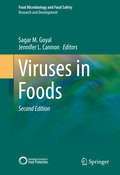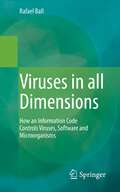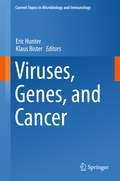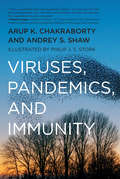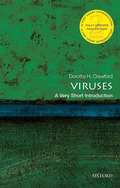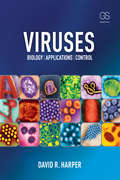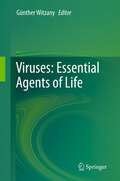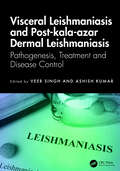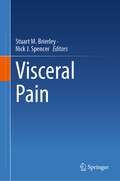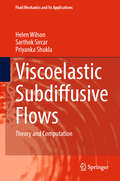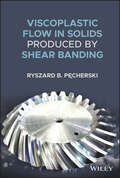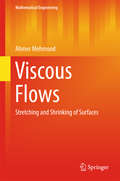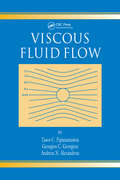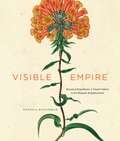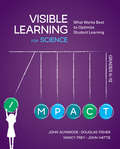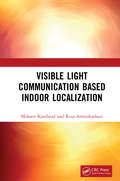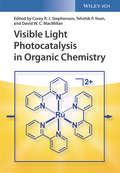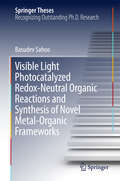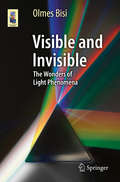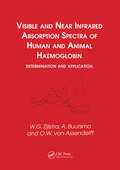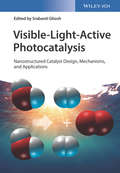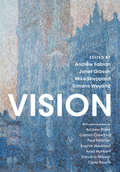- Table View
- List View
Viruses in Foods
by Sagar M. Goyal Jennifer L. CannonFoodborne viruses are an important group of pathogens recognizedto cause significant disease globally, in terms of both number ofillnesses and severity of disease. Contamination of foods by enteric viruses, such ashuman norovirus and hepatitis A and E viruses, is a major concern to publichealth and food safety. Food Virology is a burgeoning field of emphasis for scientificresearch. Many developments in foodborne virus detection, prevention and control havebeen made in recent years and are the basis of this publication. This second edition of Viruses in Foods provides anup-to-date description of foodborne viruses of public health importance, including theirepidemiology and methods for detection, prevention and control. It uniquely includes casereports of past outbreaks with implications for better control of future outbreaks, asection that can be considered a handbook for foodborne virus detection, and updated andexpanded information on virus prevention and control, with chapters on naturalvirucidal compounds in foods and risk assessment of foodborne viruses.
Viruses in all Dimensions: How an Information Code Controls Viruses, Software and Microorganisms
by Rafael BallMicroorganisms, viruses, and computer programs encode all the information necessary to reproduce and spread themselves. Yet these mechanisms are amazingly similar in the animate world, in the world of viruses, and even in the world of technical systems. The book shows how great the parallels are between these various animate and inanimate replicating systems and what they are based on.The excursion also leads into the fascinating world of genetics, to the question of what defines life and into the programming of software that multiplies itself independently. Finally, the question is derived whether and to what extent such self-replicating technical systems can become as dangerous as infectious viruses in triggering pandemics, such as the Corona pandemic in 2020.
Viruses, Genes, and Cancer (Current Topics in Microbiology and Immunology #407)
by Eric Hunter Klaus BisterThis volume focuses on virus-host cell interactions, cellular genes acquired or modulated by viruses, the pathological effects of these interactions, and therapeutic interventions. Several chapters specifically address the role of viruses and genes - such as oncogenes, proto-oncogenes, or tumor suppressor genes - in the etiology of human cancer. Oncogenic signaling by PI3 kinase, mTOR, Akt, or the major cancer drivers MYC and RAF, and the role of tumor suppressors like p53, are discussed in detail. The volume also explores the emerging role of noncoding RNAs such as microRNAs in tumorigenesis and cancer therapeutics, and offers new insights into the role of HIV-host interactions relevant to pathogenesis and treatment. Gathering contributions written by leading scientists in their respective fields, the volume offers a valuable resource for researchers and clinicians alike.
Viruses, Pandemics, and Immunity
by Arup K. Chakraborty Andrey ShawHow viruses emerge to cause pandemics, how our immune system combats them, and how diagnostic tests, vaccines, and antiviral therapies work.Throughout history, humans have contended with pandemics. History is replete with references to plagues, pestilence, and contagion, but the devastation wrought by pandemics had been largely forgotten by the twenty-first century. Now, the enormous human and economic toll of the rapidly spreading COVID-19 disease offers a vivid reminder that infectious disease pandemics are one of the greatest existential threats to humanity. This book provides an accessible explanation of how viruses emerge to cause pandemics, how our immune system combats them, and how diagnostic tests, vaccines, and antiviral therapies work-- concepts that are a foundation for our public health policies.
Viruses: A Very Short Introduction (Very Short Introductions)
by Dorothy H. CrawfordViruses are big news. From pandemics such as HIV, swine flu, and SARS, we are constantly being bombarded with information about new lethal infections. In this Very Short Introduction Dorothy Crawford demonstrates how clever these entities really are. From their discovery and the unravelling of their intricate structures, Crawford demonstrates how these tiny parasites are by far the most abundant life forms on the planet. With up to two billion of them in each litre of sea water, viruses play a vital role in controlling the marine environment and are essential to the ocean's delicate ecosystem. Analyzing the threat of emerging virus infections, Crawford recounts stories of renowned killer viruses such as Ebola and rabies as well as the less known bat-borne Nipah and Hendra viruses. Pinpointing wild animals as the source of the most recent pandemics, she discusses the reasons behind the present increase in potentially fatal infections, as well as evidence suggesting that long term viruses can eventually lead to cancer. By examining our lifestyle in the 21st century, Crawford looks to the future to ask whether we can ever live in harmony with viruses, and considers the ways in which we may need to adapt to prevent emerging viruses with devastating consequences.
Viruses: Agents of Evolutionary Invention
by Michael G. CordingleyWhile viruses—the world’s most abundant biological entities—are not technically alive, they invade, replicate, and evolve within living cells. Michael Cordingley goes beyond our familiarity with infections to show how viruses spur evolutionary change in their hosts and shape global ecosystems, from ocean photosynthesis to drug-resistant bacteria.
Viruses: Biology, Applications, and Control
by David HarperViruses: Biology, Application, and Control is a concise advanced undergraduate and graduate textbook covering the essential aspects of virology included in biomedical science courses. It is an updated and expanded version of David Harper‘s Molecular Virology 2e from the Medical Perspectives series. Selected Contents: 1. Virus Structure and Infection 2. Virus classification and evolution 3. Virus Replication 4. Viral Interaction with the Immune System 5. Vaccines and vaccination 6. Antiviral Drugs 7. Beneficial Use of Viruses 8. Emergence, transmission, and extinction 9. Viruses, vectors, and genomics 10. Virus Culture, Detection and Diagnosis Viral Replication Strategies Appe
Viruses: Essential Agents of Life
by Günther WitzanyA renaissance of virus research is taking centre stage in biology. Empirical data from the last decade indicate the important roles of viruses, both in the evolution of all life and as symbionts of host organisms. There is increasing evidence that all cellular life is colonized by exogenous and/or endogenous viruses in a non-lytic but persistent lifestyle. Viruses and viral parts form the most numerous genetic matter on this planet.
Vis Vim Vi: Declinations of Force in Leibniz’s Dynamics
by Tzuchien ThoThis book presents a systematic reconstruction of Leibniz's dynamics project (c. 1676-1700) that contributes to a more comprehensive understanding of the concepts of physical causality in Leibniz's work and 17th century physics. It argues that Leibniz's theory of forces privileges the causal relationship between structural organization and physical phenomena instead of body-to-body mechanical causation. The mature conception of Leibnizian force is not the power of one body to cause motion in another, but a kind of structural causation related to the configuration of integral systems of bodies in physical evolution. By treating the immanent philosophy of Leibniz's dynamics, this book makes explicit the systematic aims and inherent limits of Leibniz's physical project, in addition to providing an alternative vision of the scientific understanding of the physical world in the late 17th and early 18th century.
Visceral Leishmaniasis and Post-kala-azar Dermal Leishmaniasis: Pathogenesis, Treatment and Disease Control
by Pathogenesis, Treatment and Disease ControlThis reference book explores various aspects of visceral leishmaniasis (VL) and post-kala-azar dermal leishmaniasis (PKDL), including their pathophysiology, treatment options, and disease control strategies. The initial chapter provides an overview of VL, its global impact, and pathogenesis. It also examines the development of PKDL from VL, outlining the transition from the acute form of the disease to the chronic dermal condition. The book further explores the symptoms and diagnosis of both VL and PKDL. Furthermore, the book delves into the immunopathogenesis of both VL and PKDL, shedding light on the complex interactions between the parasite and the host immune system. It reviews the impact of environmental factors, particularly the contamination of arsenic and antimony in drinking water, on the progression of the disease. Lastly, the book discusses preventive measures for PKDL and highlights the major challenges in effectively implementing these strategies. This book serves as a useful resource for researchers, healthcare professionals, and policymakers seeking to deepen their understanding of these diseases and develop effective strategies for their prevention and control.Key features Provides in-depth coverage of VL and PKDL, including pathogenesis, treatment, and disease control strategies Elucidates the symptoms and diagnostic methods for VL and PKDL Offers insights into the complex immunopathogenesis of VL and PKDL, exploring the interactions between parasites and host immune system Examines treatment options for both VL and PKDL, including current therapeutic approaches and emerging strategies Reviews the impact of environmental factors, such as arsenic and antimony contamination, on the disease progression Discusses preventive measures and challenges in implementing effective strategies for PKDL prevention and control
Visceral Pain
by Nick J. Spencer Stuart M. BrierleyThe chapters in this book are based on the Visceral Pain conference in Adelaide, Australia, under the auspices of the International Federation for Neurogastroenterology and Motility in 2021. This is one of the hottest fields of science and includes mechanisms involving how the microbiome communicates with the brain and how, when disordered, these mechanisms contribute to clinical diseases such as Irritable Bowel Syndrome and Inflammatory Bowel Disease. Researchers from around the globe presented their latest findings as a review of the current state of the art in the field from both the clinical and scientific points of view. These systems are now appreciated as being critical for shaping our well-being and their disorders underlie chronic clinical conditions of significant morbidity and mortality. The author team includes long-established authorities who significantly contributed to the advances in visceral pain research over the past two decades and the new generation that will continue to contribute to advancing our understanding of the field.
Viscoelastic Subdiffusive Flows: Theory and Computation (Fluid Mechanics and Its Applications #138)
by Helen Wilson Sarthok Sircar Priyanka ShuklaThis book discusses the dynamical and rheological properties of high molecular weight entangled polymer melts, commonly known as viscoelastic subdiffusive fluids. Unlike dilute liquids, these materials exhibit molecular transport within a sublinear regime, meaning the timescale of diffusive transport is sublinear. The text emphasizes the potential of fractional calculus in modeling these fluids and introduces a novel fractional model to investigate regions of spatiotemporal instability in channel flows. At the microscale, the entanglement of polymer chains leads to localized, non-homogeneous regions with increased viscosity, which manifest as spatiotemporal macrostructures at the macroscale. To capture these macrostructures within the flow, direct numerical simulations are employed using a newly developed, physically realizable structure tensor, contributing to a deeper understanding of this complex class of fluids.
Viscoplastic Flow in Solids Produced by Shear Banding
by Ryszard B. PecherskiA complete overview of the topic of viscoplastic flow in metallic solids produced by shear banding This book presents novel ideas about inelastic deformation and failure of the material in a clear, concise manner. It exposes readers to information that will allow them to acquire the competence and ability to deal with up-to-date manufacturing and failure processes. It also portrays an interdisciplinary and revolutionary understanding of deformation processes in solids. Shear banding's typical mechanism becomes the active cause of viscoplastic flow and not the passive effect. Viscoplastic Flow in Metallic Solids Produced by Shear Banding begins with discussing the new physical model of multilevel hierarchy and evolution of micro-shear bands. It then covers the physical motivation and heuristic foundations of theoretical description concerning known results in the literature. It examines the difficulties of applying a direct multiscale integration scheme across the scales. It also presents an extension of the representative volume element (RVE) concept using the general theory of propagating the singular surfaces of the microscopic velocity field sweeping the RVE. It also reveals a new formulation of the description of the shear strain rate generated by the multilevel hierarchy of shear bands in the workflow integration approach, in which information from the simulation at different levels flows. This book: Presents fresh ideas about inelastic deformation and failure of materials Provides readers with the competence and ability to deal with up-to-date manufacturing and failure processes Sheds light on the interdisciplinary revolution in the recent understanding of deformation processes in solids Viscoplastic Flow in Metallic Solids Produced by Shear Banding will appeal to researchers studying physical foundations of inelastic deformation of materials and dealing with numerical simulations of manufacturing processes. It is also an excellent resource for graduate and postgraduate students of material science and mechanical engineering faculties.
Viscous Flows
by Ahmer MehmoodExact solution of Navier-Stokes equations is possible only for very simple flow situations such as unidirectional flows. Due to the nonlinear nature of these equations their analytic solutions are rare and the situation gets worse in the case of unsteady and multidimensional flow problems. In this book we report highly accurate and purely analytic solutions to some steady/unsteady multidimensional viscous flows over flat surface. Heat transfer analysis has also been carried out where the flat surface is considered as a stretching sheet. In each case the skin friction and the rate of heat transfer has been reported. The issue of cooling of stretching sheet in the presence of viscous dissipation has been discussed in detail. We have used homotopy analysis method to solve the governing nonlinear differential equations. The results are purely analytic and highly accurate. The accuracy of results has been proved by calculating the residual errors and (or) giving the comparison with the existing results. for unsteady flows it is worthy to mention here that our analytic solutions are uniformly valid for all time in the whole spatial domain.
Viscous Fluid Flow
by Tasos Papanastasiou Georgios Georgiou Andreas N. Alexandrou"With the appearance and fast evolution of high performance materials, mechanical, chemical and process engineers cannot perform effectively without fluid processing knowledge. The purpose of this book is to explore the systematic application of basic engineering principles to fluid flows that may occur in fluid processing and related activities.In Viscous Fluid Flow, the authors develop and rationalize the mathematics behind the study of fluid mechanics and examine the flows of Newtonian fluids. Although the material deals with Newtonian fluids, the concepts can be easily generalized to non-Newtonian fluid mechanics. The book contains many examples. Each chapter is accompanied by problems where the chapter theory can be applied to produce characteristic results.Fluid mechanics is a fundamental and essential element of advanced research, even for those working in different areas, because the principles, the equations, the analytical, computational and experimental means, and the purpose are common.
Visible Empire: Botanical Expeditions and Visual Culture in the Hispanic Enlightenment
by Daniela BleichmarBetween 1777 and 1816, botanical expeditions crisscrossed the vast Spanish empire in an ambitious project to survey the flora of much of the Americas, the Caribbean, and the Philippines. While these voyages produced written texts and compiled collections of specimens, they dedicated an overwhelming proportion of their resources and energy to the creation of visual materials. European and American naturalists and artists collaborated to manufacture a staggering total of more than 12,000 botanical illustrations. Yet these images have remained largely overlooked—until now. In this lavishly illustrated volume, Daniela Bleichmar gives this archive its due, finding in these botanical images a window into the worlds of Enlightenment science, visual culture, and empire. Through innovative interdisciplinary scholarship that bridges the histories of science, visual culture, and the Hispanic world, Bleichmar uses these images to trace two related histories: the little-known history of scientific expeditions in the Hispanic Enlightenment and the history of visual evidence in both science and administration in the early modern Spanish empire. As Bleichmar shows, in the Spanish empire visual epistemology operated not only in scientific contexts but also as part of an imperial apparatus that had a long-established tradition of deploying visual evidence for administrative purposes.
Visible Learning for Science, Grades K-12: What Works Best to Optimize Student Learning
by Douglas Fisher John Hattie Dr Nancy Frey John T. AlmarodeInquiry, laboratory, project-based learning, discovery learning—which science instructional approach is most effective? In Visible Learning for Science, the authors reveal that it’s not which strategy, but when, and plot a vital K-12 framework for choosing the right approach at the right time, depending on where students are within the three phases of learning: surface, deep, and transfer. Synthesizing state-of-the-art science instruction and assessment with John Hattie’s cornerstone educational research, this book empowers you to plan, develop, and implement high-impact instruction at each phase so all students demonstrate more than a year’s worth of learning for every year in school.
Visible Learning for Science, Grades K-12: What Works Best to Optimize Student Learning
by Douglas Fisher John Hattie Dr Nancy Frey John T. AlmarodeInquiry, laboratory, project-based learning, discovery learning—which science instructional approach is most effective? In Visible Learning for Science, the authors reveal that it’s not which strategy, but when, and plot a vital K-12 framework for choosing the right approach at the right time, depending on where students are within the three phases of learning: surface, deep, and transfer. Synthesizing state-of-the-art science instruction and assessment with John Hattie’s cornerstone educational research, this book empowers you to plan, develop, and implement high-impact instruction at each phase so all students demonstrate more than a year’s worth of learning for every year in school.
Visible Light Communication Based Indoor Localization
by Mohsen Kavehrad Reza AminikashaniThis book demonstrates the research on VLC based indoor localization in four aspects: first, it constructs the concept and model of the system; second, positioning algorithms, as the main issue in indoor localization, are detailed; third, many approaches are proposed to further improve the positioning performance; fourth, challenges will be detailed. Impulse response with multipath reflections are analyzed. Orthogonal frequency division multiplexing (OFDM) is proposed, and positioning performance is largely improved compared to On-off-keying (OOK) modulation. The readers will get a broad view of VLC based indoor localization from the background to the future challenges.
Visible Light Photocatalysis in Organic Chemistry
by Corey R.J. Stephenson Tehshik P. Yoon David W.C. MacMillanFilling the need for a ready reference that reflects the vast developments in this field, this book presents everything from fundamentals, applications, various reaction types, and technical applications. Edited by rising stars in the scientific community, the text focuses solely on visible light photocatalysis in the context of organic chemistry. This primarily entails photo-induced electron transfer and energy transfer chemistry sensitized by polypyridyl complexes, yet also includes the use of organic dyes and heterogeneous catalysts. A valuable resource to the synthetic organic community, polymer and medicinal chemists, as well as industry professionals.
Visible Light Photocatalyzed Redox-Neutral Organic Reactions and Synthesis of Novel Metal-Organic Frameworks
by Basudev SahooThis unique thesis discusses the development of conceptually novel and synthetically valuable methods that use visible light photocatalysis. Each chapter addresses a different topic in the emerging field of photocatalysis, which has become an indispensable tool for organic synthesis. Photocatalysis employs environmentally harmless and abundant visible light in the presence of a photosensitizer, and as such offers an attractive alternative to harmful UV light in photo-mediated reactions. This book introduces the novel concept of merging gold catalysis with visible light photocatalysis in a dual catalytic fashion, which demonstrates their compatibility with each other for first time and has inspired the development of various reactions. Moreover, a novel trifluoromethylation method, which combines radical addition chemistry with a polar rearrangement to synthesize valuable fluorinated compounds, is presented, since compounds featuring fluorinated functionality are the subject of increasing attention in pharmaceutical, agrochemical and material research. It also develops an external photocatalyst-free photochemical method for the synthesis of valuable indolizine heterocycles, where the product mediates its own formation. Lastly, it describes the synthesis and characterization of two novel highly porous metal-organic frameworks (MOFs). The comprehensive text is rounded out with illustrations and color figures.
Visible and Invisible
by Olmes BisiLight phenomena have intrigued humankind since prehistory. Think of the rainbow, a sunset on the sea, a game of shadows. Humans have always used light for their own needs, from cooking food to illuminating a room. However, light is not only limited to what we can see with our eyes. The invisible part of the electromagnetic spectrum is broad and dynamic. This book outlines the mysteries and wonders of electromagnetism, heat, and light. It also covers the history of our scientific understanding of light. The dark as well as the bright sides of light are fully explored in these pages, from their impact on our world to their use in cutting-edge technologies in a variety of fields. Numerous full-color images and drawings complement the text, and light phenomena are explained in a simple and engaging way.
Visible and Near Infrared Absorption Spectra of Human and Animal Haemoglobin determination and application
by Willem G. Zijlstra Anneke Buursma Onno W. van AssendelftThe bright colour of haemoglobin has, from the very beginning, played a significant role in both the investigation of this compound as well as in the study of blood oxygen transport. Numerous optical methods have been developed for measuring haemoglobin concentration, oxygen saturation, and the principal dyshaemoglobins in vitro as well as in vivo.
Visible-Light-Active Photocatalysis: Nanostructured Catalyst Design, Mechanisms, and Applications
by Srabanti GhoshA comprehensive and timely overview of this important and hot topic, with special emphasis placed on environmental applications and the potential for solar light harvesting. Following introductory chapters on environmental photocatalysis, water splitting, and applications in synthetic chemistry, further chapters focus on the synthesis and design of photocatalysts, solar energy conversion, and such environmental aspects as the removal of water pollutants, photocatalytic conversion of CO2. Besides metal oxide-based photocatalysts, the authors cover other relevant material classes including carbon-based nanomaterials and novel hybrid materials. Chapters on mechanistic aspects, computational modeling of photocatalysis and Challenges and perspectives of solar reactor design for industrial applications complete this unique survey of the subject. With its in-depth discussions ranging from a comprehensive understanding to the engineering of materials and applied devices, this is an invaluable resource for a range of disciplines.
Vision (Darwin College Lectures)
by Carlo Rovelli Paul Fletcher Andrew Blake Carolin Crawford Sophie Hackford Anya Hurlbert Dan-Eric NilssonArising from the 2019 Darwin College Lectures, this book presents essays from seven prominent public intellectuals on the theme of vision. Each author examines this theme through the lens of their own particular area of expertise, making for a lively interdisciplinary volume including chapters on neuroscience, colour perception, biological evolution, astronomy, the future of technology, computer vision, and the visionary core of science. Featuring contributions by professors of neuroscience Paul Fletcher and Anya Hurlbert, professor of zoology Dan-Eric Nilsson, the futurist Sophie Hackford, Microsoft distinguished scientist Andrew Blake, theoretical physicist and author Carlo Rovelli, and Dr Carolin Crawford, the Public Astronomer at the University of Cambridge, this volume will be of interest to anybody curious about how we see the world.
